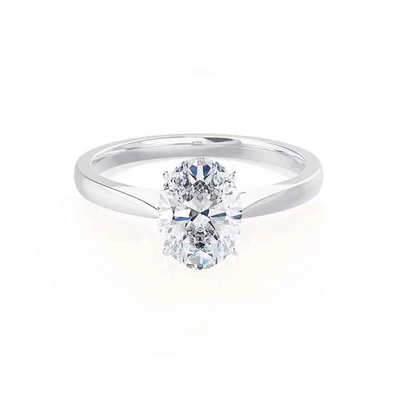Choosing the perfect engagement ring involves more than selecting a beautiful gemstone. The setting, which holds and showcases the stone, plays a vital role in the overall design, durability, and personality of the ring. For example, if you’re drawn to the timeless elegance of an oval solitaire engagement ring, understanding its setting options can help you highlight its classic beauty while ensuring long-lasting comfort and security. This guide will walk you through the most popular engagement ring settings and what makes each unique.
The solitaire setting remains one of the most iconic and beloved choices, especially for those who prefer simplicity with sophistication. An oval solitaire engagement ring, for instance, places the oval-shaped diamond prominently on a plain metal band, allowing the stone’s brilliance to take center stage. This setting is ideal for showcasing the natural beauty of the diamond without any distractions. It also complements a wide range of personal styles, from traditional to modern minimalism.
Next, consider the halo setting, which encircles the center stone with a border of smaller diamonds or gemstones. This arrangement enhances the overall sparkle of the ring and creates the illusion of a larger center stone. The halo setting works beautifully with all diamond shapes, including ovals, and adds an element of glamour and opulence. It’s especially favored by those who want a vintage or romantic aesthetic.
The pavé setting is another popular choice, where the band is encrusted with tiny diamonds that are set closely together, giving the appearance of a continuous sparkle. This design can elevate the visual impact of the ring and add texture and brilliance to a simple band. It’s perfect for those who appreciate intricate details and want their ring to shimmer from every angle.
A bezel setting, on the other hand, is known for its practicality and sleek look. In this setting, the stone is completely or partially surrounded by a thin metal rim that holds it securely in place. This modern and secure design is ideal for active lifestyles and is less prone to catching on clothing or surfaces. It offers a clean and contemporary aesthetic while protecting the edges of the gemstone.
For those looking for something a bit more unique, the three-stone setting presents a symbolic option. Typically, the center stone is flanked by two smaller stones on either side. This setting is said to represent the past, present, and future, making it a meaningful choice for many couples. It also allows for customization with different stones or shapes, creating a one-of-a-kind piece.
The cathedral setting is another timeless design that uses arch-like metal structures to elevate the center stone. This architecture-inspired setting gives the ring a regal and sophisticated look. It can make the diamond appear larger and more prominent, ideal for those who want a dramatic effect without adding more stones. For more helpful blog posts like this one, visit the rest of our site, My USA Wire.
Lastly, the tension setting is a modern and daring option where the diamond is held in place by pressure from the metal band, creating the illusion that it is floating. This setting is visually striking and minimalist, but it requires precision engineering and is often better suited for harder gemstones like diamonds.
Choosing the right engagement ring setting is a deeply personal decision that should align with both your aesthetic tastes and everyday lifestyle. Whether you’re captivated by the understated elegance of an oval solitaire engagement ring or the dazzling brilliance of a halo design, understanding the characteristics of each setting empowers you to make a thoughtful and confident choice. The right setting not only enhances the beauty of your chosen gemstone but also ensures comfort, security, and longevity. Ultimately, it’s about creating a ring that reflects your love story-timeless, personal, and uniquely yours.
